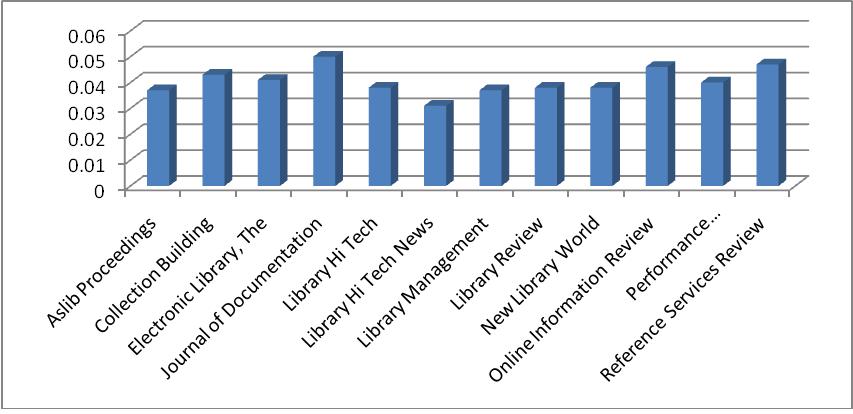
Webology, Volume 8, Number 1, June, 2011 |
| Home | Table of Contents | Titles & Subject Index | Authors Index |
Neeraj Kumar Singh
Assistant Librarian, A C Joshi Library, Panjab University, Sector-14 Chandigarh 160014, India. E-mail: neerajkumar_78 (at) yahoo.co.in
Jyoti Sharma
Library Assistant, Panjab University, Sector-14 Chandigarh-160014, India. Email: dj_mukul (at) yahoo.co.in
Navneet Kaur
Library Assistant, Niift, Mohali, India. E-mail: neeru580 (at) gmail.com
Received June 5, 2011; Accepted June 24, 20011
Citation analysis of all the journal articles published in the Journal of Documentation from 1996-2010 is carried out. 487 articles are published in the journal during 15 years. Highest numbers (44) of articles are published in the year 2005. The journal contained 15587 citations from 1996-2010. Average number of citation per article is maximum in the year 2009. This study also covers the analyses of authorship patterns in citing article. In authorship pattern, single author citations are dominant than others and it is 201 (49%). This study also reveals that Journal of Documentation is the most preferred journal used by authors in their citation. The paper concludes that only 10 core periodicals can cover more than 2951 (16 %) references.
Citation analysis; Journal of Documentation; Scopus; Bibliometrics
Citation analysis is one of the important and quite old branches of bibliometric study (Mahapatra, 2000) given by Eugene Garfield. It examines the different frequencies, their patterns and graphs of citations given in articles, review papers, technical communication, theses and books. Citations are used in scholarly works to establish links to other works and researchers, which forms a part of primary scientific communication in a geographical proximity (Binwal, Chandel, & Saraf, 1990). Citation Analysis is used as research evaluation tool mostly used in library and information science.
Journal of Documentation is a highly regarded journal, which provides a forum for the dissemination of scholarly articles, research reports and critical reviews in library and information science. It provides a link between research and scholarship and reflective professional practice so that all are informed and enhanced (Emeraldinsight, 2011). The journal regularly achieves the highest citation ratings in ISI Web of Science for comparable titles.
The main objectives of this study are:
The journal has so far completed 67 volumes. The present study covers volume 52 to volume 66, i.e. from 1996-2010. The study limited to 413 articles and 15587 citations published in last 15 years in the Journal of Documentation. The entire data and figures are derived from Scopus citation database. Selection of journal is very important for such type of study. Emerald is a leading independent publication of global research with impact in business, society, public policy education and library and information science, so we have decided to include emerald journal for this study. Emerald is currently publishing 22 journals in the area of library and information science. With the help of Scopus citation database we took SJR of these journals and out of 22 journals only 12 journals SJR are available in Scopus. Among these, Journal of Documentation has higher SJR (0.05) then Reference Services Review (0.047) followed by Online Information Review (0.046). Therefore, we have decided to select Journal of Documentation for this study. Whole records regarding journals SJR can be seen from Table 1.
| Sr. No. | Emerald Journal Title | Scopus SJR |
|---|---|---|
| 1 | Aslib Proceedings | 0.037 |
| 2 | Collection Building | 0.043 |
| 3 | Electronic Library, The | 0.041 |
| 4 | Journal of Documentation | 0.05 |
| 5 | Library Hi Tech | 0.038 |
| 6 | Library Hi Tech News | 0.031 |
| 7 | Library Management | 0.037 |
| 8 | Library Review | 0.038 |
| 9 | New Library World | 0.038 |
| 10 | Online Information Review | 0.046 |
| 11 | Performance Measurement and Metrics | 0.04 |
| 12 | Reference Services Review | 0.047 |

Jan (2009) in her work done Citation Analysis of Library Trends from 1994-2007 comprises 593 articles and each articles published during that period were examined and highest number (52) of articles were published in 2004. The journal contained 15662 references 13783 were p-citations and 1879 were e-citations. Jan (2009) examined 44.51% print books were consulted by the authors and 0% e-books were accessed. Findings indicated that authors consulted 44.04% p-journals and 11.82% e-journals. It was found that female contribution (52.34%) accounted more than male contribution (47.66%).
Jadhav Vandana, Khaparde, and Shelke Santosh (2011) did Citation Analysis of University News Journal. The articles published in the journal from January 2004 to December 2008 in which 5 volumes and 261 issues were covered. Total citations were 5968 and maximum referred citations were in 2007 and 2008 that is 2950 (50-60%). Books were most cited document, i.e. 1549 (29.39%) and maximum numbers of citations were taken from indie that is 3675 (62.61%). English language predominant that is 5968 and single authored citations dominant than others that is 3011 (51.30%).
Shokeen and Kaushik (2004) in their study entitled "Indian Journal of Plant Physiology: A Citation Analysis", covered the issues published between January to December 2002, issue number 1 to 4 of volume 7, 61 articles published in these issues. 1149 citations featuring 2770 authors during that period. 39% cited articles are three authored. The ratio of author self-citation to total citations was 1:16.65 and the ratio of author self-citation of total citation was 1:31.91. The average number of articles published in each issue was 15.25, which were higher than others.
In this present study, Scopus citation database has been used. Scopus is the world's largest abstract and citation database of peer-reviewed literature and quality web sources. As per Scopus citation database, there are 487 documents published in the Journal of Documentation from 1996 to 2010. Out of which 413 are articles and 74 are others documents which includes book review, conference papers, etc. The references listed for each document are examined and duplicate references in each individual list were removed. The collected data have been analyzed and is presented in the form of tables and figures (Ramesh & Nagaraju, 2000).
Table 2 shows the there is a variation in the frequency of this journal for example in 1996 the frequency is quarterly as volume 52 has 4 issues, after that from the year 1997-99 (Vol. 53-55) the journal published 5 issues per year. From 2000 onward, the publication is bimonthly as it is clearly visible that from 2000-2010, volume 56-66 has 6 issues. Total numbers of documents published during 1996-2010 were 487. Out of which articles were 413, reviews were 69 and others are 5. The distribution of documents by volume shows that number of documents in 2005 is higher with 44 documents and minimum 15 documents in the year 1996. The range of documents published during 1996-2010 is 15-44. It is noted that more than 40 documents published in the year 2005, 2007 to 2010. This figure reflects that there is an increase in number of publishing documents. It also reveals that articles are 413 out of the total documents 487, i.e. 85%, reviews are 14% and others are 1% of the total documents.
| Year | Volume * | Articles | Reviews | Others | Total Documents (Articles+Reviews+Others) |
|---|---|---|---|---|---|
| 1996 | 52 | 12 | 3 | -- | 15 |
| 1997 | 53 | 19 | 5 | -- | 24 |
| 1998 | 54 | 18 | 6 | 3 | 27 |
| 1999 | 55 | 19 | 3 | -- | 22 |
| 2000 | 56 | 26 | 6 | -- | 32 |
| 2001 | 57 | 29 | 2 | -- | 31 |
| 2002 | 58 | 23 | 3 | -- | 26 |
| 2003 | 59 | 25 | 3 | -- | 28 |
| 2004 | 60 | 16 | 16 | 2 | 34 |
| 2005 | 61 | 31 | 13 | -- | 44 |
| 2006 | 62 | 36 | -- | -- | 36 |
| 2007 | 63 | 41 | -- | -- | 41 |
| 2008 | 64 | 37 | 6 | -- | 43 |
| 2009 | 65 | 41 | 1 | -- | 42 |
| 2010 | 66 | 40 | 2 | -- | 42 |
| Total | 413 | 69 | 5 | 487 |
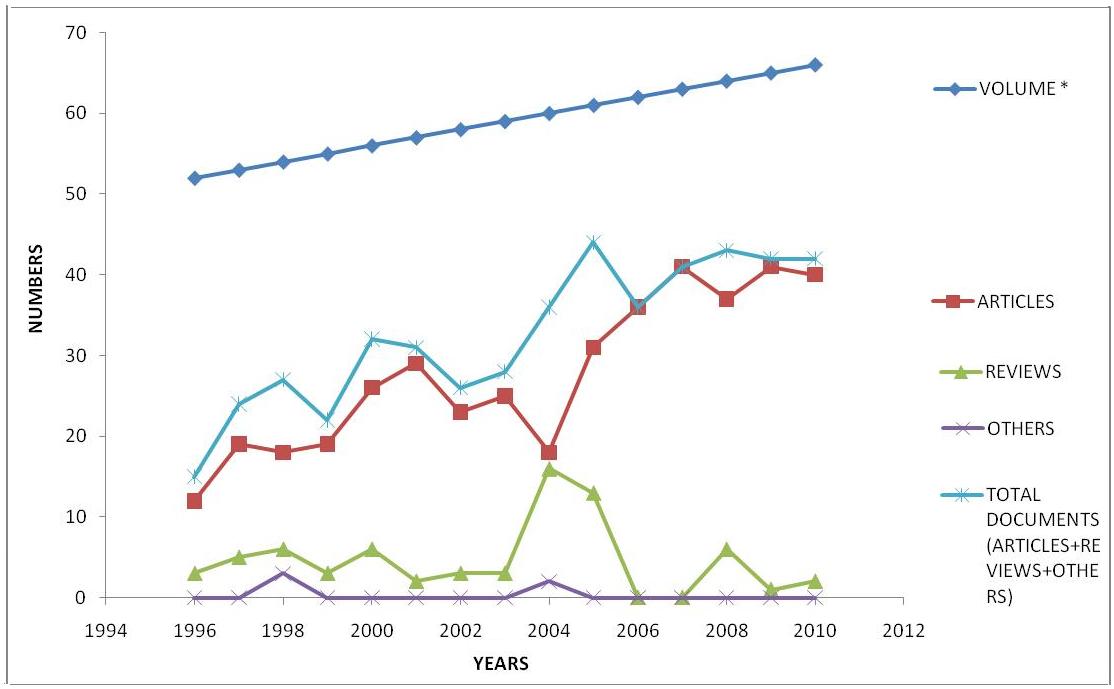
Table 3 indicates that the total number of articles published during 1996-2010 was 413 and the total number of citations was 15587. Year wise analysis of citation shows that average number of citation per article is maximum (45.9) in the year 2009 and minimum (18) in the year 1997. The present study reveals that average number of citations per article is increasing.
| Sr. No. | Year | Vol. No. | No. of articles | Total No. of citations | Average no. of citation/article |
|---|---|---|---|---|---|
| 1 | 1996 | 52 | 12 | 350 | 29.2 |
| 2 | 1997 | 53 | 19 | 343 | 18.0 |
| 3 | 1998 | 54 | 18 | 513 | 28.5 |
| 4 | 1999 | 55 | 19 | 700 | 36.8 |
| 5 | 2000 | 56 | 26 | 1006 | 38.7 |
| 6 | 2001 | 57 | 29 | 1201 | 41.4 |
| 7 | 2002 | 58 | 23 | 941 | 40.9 |
| 8 | 2003 | 59 | 25 | 979 | 39.2 |
| 9 | 2004 | 60 | 16 | 381 | 21.2 |
| 10 | 2005 | 61 | 31 | 1044 | 33.7 |
| 11 | 2006 | 62 | 36 | 1228 | 34.1 |
| 12 | 2007 | 63 | 41 | 1638 | 39.9 |
| 13 | 2008 | 64 | 37 | 1563 | 42.2 |
| 14 | 2009 | 65 | 41 | 1884 | 45.9 |
| 15 | 2010 | 66 | 40 | 1816 | 45.4 |
| Total | Years - 15 | Vol. - 15 | 413 | 15587 | 535.1 |
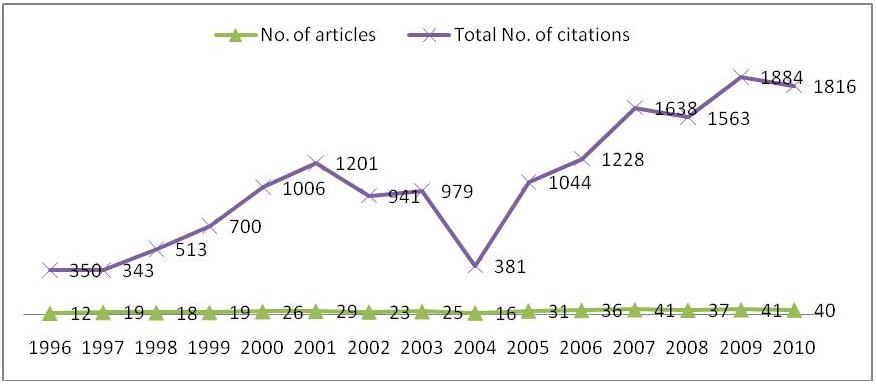
Table 4 indicates that out of the total number of citations in total documents 18324, article citations were more in number, i.e. 5884 (32%) than other type of cited documents like 998 (5%) citations from conference proceedings,1075 (6%) citations from reviews and citations from other sources (books, editorials, letters, notes and short surveys) were 10367 (57%).
| Sr. No. | Years | Total number of citations in total documents | Articles | Conference proceedings | Reviews | Other sources (books, editorials, letters, notes and short surveys) |
|---|---|---|---|---|---|---|
| 1 | 1996 | 572 | 237 | 44 | 18 | 273 |
| 2 | 1997 | 515 | 190 | 62 | 17 | 246 |
| 3 | 1998 | 772 | 171 | 20 | 35 | 546 |
| 4 | 1999 | 829 | 179 | 35 | 69 | 546 |
| 5 | 2000 | 1105 | 378 | 58 | 51 | 618 |
| 6 | 2001 | 1294 | 337 | 95 | 57 | 805 |
| 7 | 2002 | 1095 | 326 | 57 | 49 | 663 |
| 8 | 2003 | 1094 | 108 | 30 | 20 | 936 |
| 9 | 2004 | 1029 | 386 | 33 | 37 | 573 |
| 10 | 2005 | 1464 | 404 | 67 | 64 | 929 |
| 11 | 2006 | 1228 | 498 | 112 | 84 | 534 |
| 12 | 2007 | 1638 | 582 | 89 | 100 | 867 |
| 13 | 2008 | 1795 | 640 | 98 | 130 | 927 |
| 14 | 2009 | 1934 | 696 | 98 | 192 | 948 |
| 15 | 2010 | 1960 | 752 | 100 | 152 | 956 |
| Total | 18324 | 5884 | 998 | 1075 | 10367 |
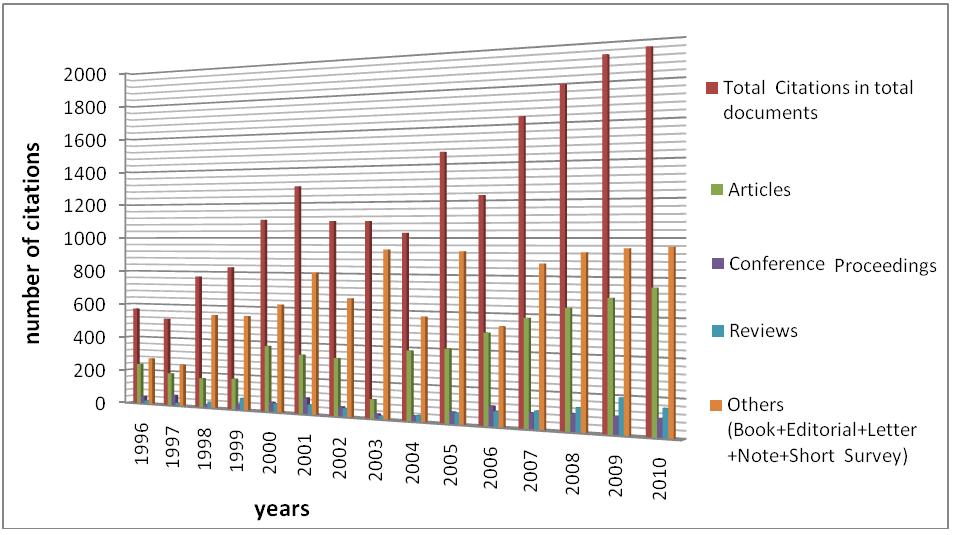
Table 5 shows detailed study of source titles cited during 1996-2010 and Table 6 shows ranking of journals, which is based on the journals that are cited most frequently out of the total 18324 citations. Journal of Documentation is on the top with 795 then journal of American society for information science is second with 599 and so on. This study reveals that Journal of Documentation is most preferred journal.
| Source title | No. of times cited | Rank |
|---|---|---|
| Journal of Documentation | 795 | 1 |
| Journal of the American Society for Information Science | 599 | 2 |
| Information Processing and Management | 434 | 3 |
| Scientometrics | 284 | 4 |
| Journal of Information Science | 264 | 5 |
| Annual Review of Information Science and Technology | 154 | 6 |
| Library Trends | 132 | 7 |
| Library & Information Science Research | 114 | 8 |
| Information Research | 99 | 9 |
| Journal of Academic Librarianship | 76 | 10 |
This table shows top 10 journals in which Journal of Documentation was cited 795 times out of 18324 that is 4.34% of the total citations; and 10 core periodicals covered more than 2951 (16 %) references.
| Code | 1996 | 1997 | 1998 | 1999 | 2000 | 2001 | 2002 | 2003 | 2004 | 2005 | 2006 | 2007 | 2008 | 2009 | 2010 | Total | Percentage |
|---|---|---|---|---|---|---|---|---|---|---|---|---|---|---|---|---|---|
| 1 | 31 | 36 | 37 | 32 | 43 | 58 | 37 | 60 | 50 | 79 | 51 | 57 | 60 | 81 | 83 | 795 | 4.34 |
| 2 | 39 | 31 | 37 | 20 | 51 | 37 | 30 | 40 | 59 | 45 | 33 | 38 | 58 | 54 | 27 | 599 | 3.27 |
| 3 | 19 | 32 | 19 | 6 | 27 | 25 | 18 | 23 | 37 | 33 | 30 | 35 | 36 | 53 | 41 | 434 | 2.37 |
| 4 | 13 | 12 | 10 | 6 | 11 | 12 | 12 | 18 | 37 | 12 | 18 | 23 | 48 | 23 | 29 | 284 | 1.55 |
| 5 | 8 | 16 | 16 | 9 | 17 | 16 | 15 | 22 | 13 | 16 | 19 | 22 | 21 | 26 | 28 | 264 | 1.44 |
| 6 | - | - | 4 | 5 | 9 | 8 | 6 | 17 | 12 | 10 | 15 | 11 | 18 | 24 | 15 | 154 | 0.84 |
| 7 | - | - | 4 | 10 | 10 | 3 | 8 | 6 | 7 | 9 | 8 | 10 | 25 | 12 | 20 | 132 | 0.72 |
| 8 | 3 | 2 | 3 | - | - | 6 | 4 | 10 | 6 | 7 | 7 | 22 | 15 | - | 29 | 114 | 0.62 |
| 9 | - | - | - | - | - | - | 4 | - | 5 | 8 | 11 | - | - | 40 | 31 | 99 | 0.54 |
| 10 | - | - | 4 | 3 | - | 6 | - | 3 | - | - | - | 5 | 19 | 20 | 16 | 76 | 0.41 |
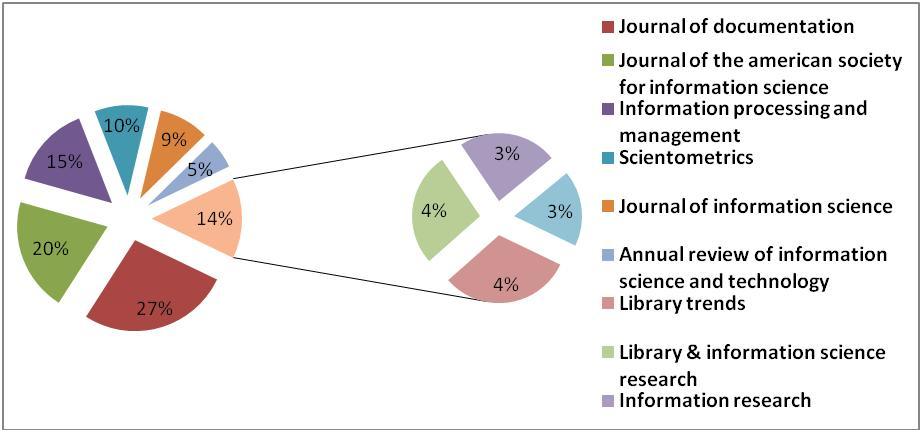
Authorship pattern has been studied with 413 articles which is shown in this table. It was revealed that the number of single authored articles was 201 (49%), two authored articles 126 (31%), three authored articles 55 (13%), and more than three authored articles 31 (7%). The highest percentage goes to single authored articles and lowest is more than three authored articles. While our study during preparing this table we notice that there are 1 article contributed by seven authors that is highest in this journal and 4 articles are contributed by 6 authors.
| Years | Single Author | Two Author | Three Author | More Than Three | Total Articles |
|---|---|---|---|---|---|
| 1996 | 6 | 4 | 1 | 1 | 12 |
| 1997 | 9 | 6 | 2 | 2 | 19 |
| 1998 | 7 | 8 | 3 | - | 18 |
| 1999 | 12 | 4 | 2 | 1 | 19 |
| 2000 | 12 | 8 | 5 | 1 | 26 |
| 2001 | 15 | 8 | 4 | 2 | 29 |
| 2002 | 15 | 3 | 5 | - | 23 |
| 2003 | 11 | 6 | 6 | 2 | 25 |
| 2004 | 8 | 5 | 2 | 1 | 16 |
| 2005 | 17 | 7 | 7 | - | 31 |
| 2006 | 19 | 8 | 4 | 5 | 36 |
| 2007 | 14 | 17 | 5 | 5 | 41 |
| 2008 | 14 | 17 | 4 | 2 | 37 |
| 2009 | 26 | 7 | 3 | 5 | 41 |
| 2010 | 16 | 18 | 2 | 4 | 40 |
| Total Authors | 201 | 126 | 55 | 31 | 413 |
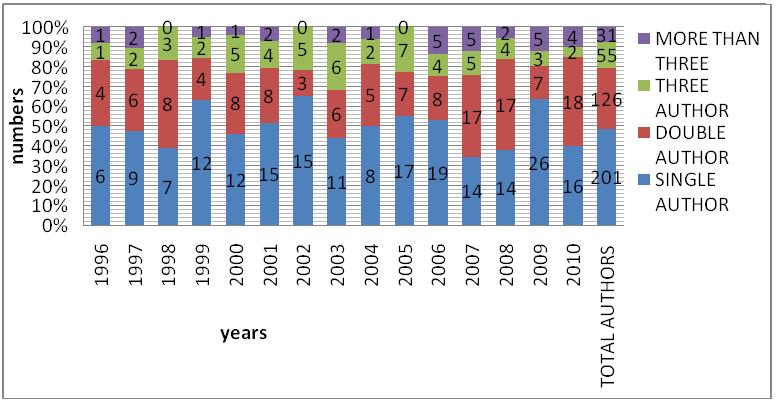
Distribution of document by volume shows total number of documents were 487 including all Articles, reviews and others. Volume wise distribution of citations shows total 15587 citations from the year 1996-2010. On an average 1039 citations were used per year. The maximum number of citation was in the year 2009 that is 1884 (12%) and the minimum number of citation was in the year 1997 that is 343 (2%). The composition of citations indicates that the total number of citation in the total documents were 18324 which includes 5884 (articles), 998 (conference proceedings), 1075 (reviews) and 10367 (others- books, editorials, letters, notes and short surveys). More citations were from the articles than the other type of materials .Yearly study of source title showed top 10 journals with every year number of times they were cited. In aggregation of total number of citations Journal of Documentation was on the top with 795 citations and then Journal of the American society for information science was ranked second with 599 citations and so on. The authorship pattern of citations shows that the Single authorship pattern are more in numbers that is 201 (49%) and more than three authored citations are lowest in numbers that is 31 (8%).